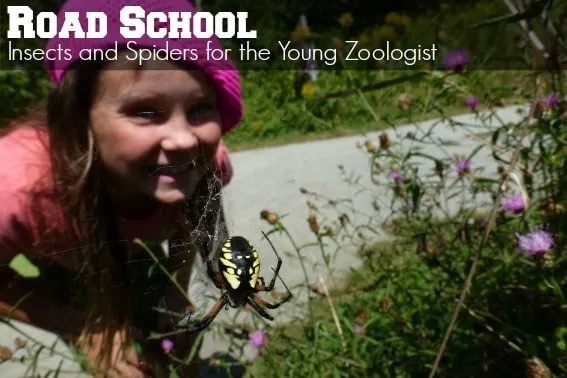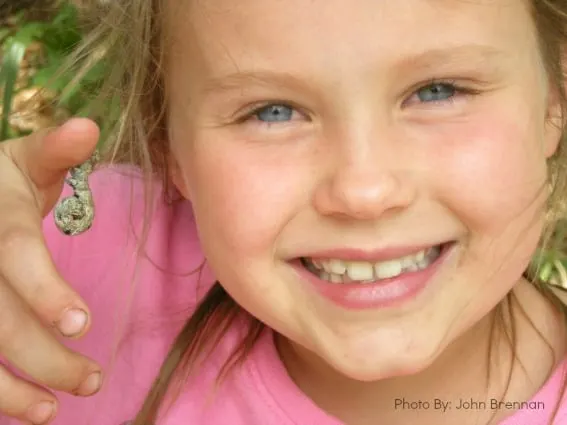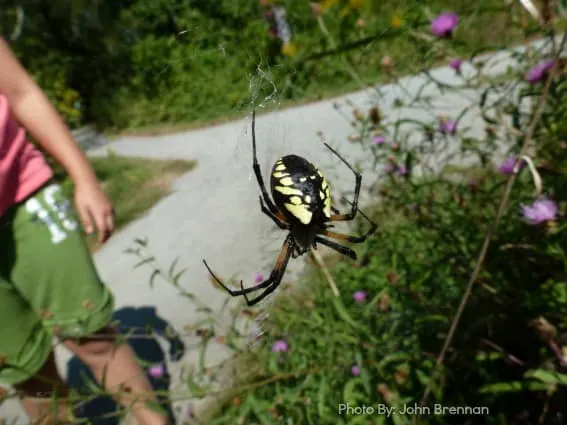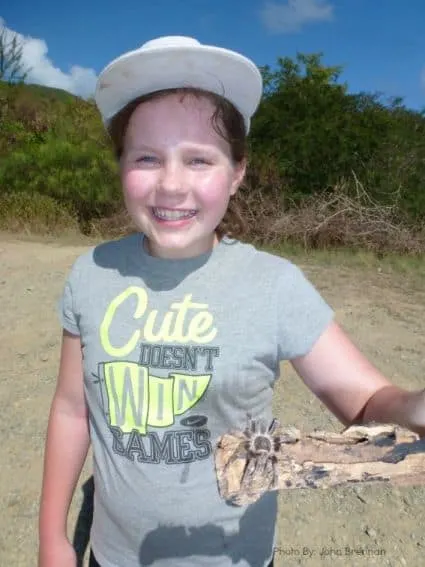Our family’s love affair with insects and spiders began 10 years ago when our twins were only two years old. As an arachnophobe, I was begrudgingly coerced into becoming a mom who was interested in spiders and insects when I discovered that I had budding entomologists on my hands. Ten years later and our twelve-year-old daughter is a trusted source of information regarding insects based on what she has studied, learned, traveled to see, and even checked out in our own backyard here in New England. On many family trips we have scouted out places where her thirst for more insect and spider knowledge can be quenched. Along the way our other two children, as well as us phobic parents have learned much about the subject.
Insects and Spiders for Every Age
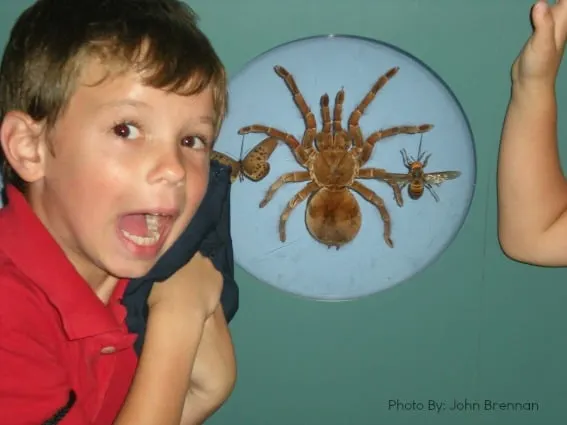
Entomology and arachnology are branches of zoology. It would seem that all little children are somewhat interested in insects and spiders since these critters are small, mobile, and easily identifiable to children. In speaking with Dr. Gale E. Ridge, an entomologist from The Connecticut Agricultural Experiment Station in New Haven, Connecticut, I discovered that learning about insects and spiders is somewhat limited in our schools. There is a heavy emphasis on identification, but a much smaller emphasis on insect biology and their importance to the vitality of our environment. There is so much more to be learned about insects and spiders and the material can easily by divided by student ages and subject material resulting in an in-depth and interesting study at any age. Toddlers might be most interested in what insects and spiders do, young children might like to learn more about identification, while older children may be most interested in how insects impact the ecological world around us. Since it is estimated that there are 10 quintillion insects sharing earth with us, it would serve us well to learn as much as we can about them and how they impact our lives!
Little Learners
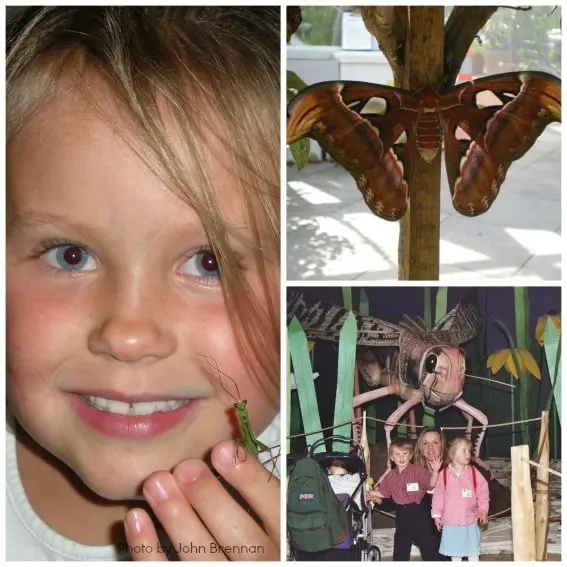 The youngest children will be most interested in the structure of insects and spiders, their development, and their daily lives. Unfortunately, after learning about butterfly metamorphosis, the study of insects ends for many school-aged children. When teaching about body structure and identification, we found that hands on play dough models worked best for our children during their toddler years. Other concepts are best reinforced by participation in zoo programs. There are terrific zoo programs and exhibits available to teach kids the differences between insects and spiders across the country. Explore your backyard and search for insects and spider during nature hikes and treks. Pack a magnifying glass and be ready to turn over stumps and rocks to find new species. Encourage a love of these creatures and be an example by avoiding anxiety so your children can learn more about insect life without fear.
The youngest children will be most interested in the structure of insects and spiders, their development, and their daily lives. Unfortunately, after learning about butterfly metamorphosis, the study of insects ends for many school-aged children. When teaching about body structure and identification, we found that hands on play dough models worked best for our children during their toddler years. Other concepts are best reinforced by participation in zoo programs. There are terrific zoo programs and exhibits available to teach kids the differences between insects and spiders across the country. Explore your backyard and search for insects and spider during nature hikes and treks. Pack a magnifying glass and be ready to turn over stumps and rocks to find new species. Encourage a love of these creatures and be an example by avoiding anxiety so your children can learn more about insect life without fear.
Little kids never tire of learning about metamorphosis from caterpillar to butterfly. Beginner entomologists will thrive at butterfly houses. After having read “The Very Hungry Caterpillar,” they can watch metamorphosis live, and then enjoy the fluttering butterflies. Magic Wings Conservatory in Deerfield, Massachusetts and Butterfly World in Boca Raton, Florida are two suggested stops. Kids also enjoy active bee hives similar to those they may be found at Squam Lakes Science Center in New Hampshire or pop-up displays that might be available at Epcot in Florida or at New York’s Bronx Zoo where the basics of insect structure are taught. The Inn by the Sea in Cape Elizabeth, Maine is designated as a butterfly way station for migrating Monarchs, and holds an annual program for little bug lovers called the Bugs Life Garden Tour. Child guests at this luxury property can dress up in insect gear, and head out into the area near the inn to discover insect habitat from the bugs’ point of view. There are also adult program offered to teach adults about creating an insect habitat at home.
School-Aged Children
When your child is of school age their interest can be piqued by delving into the subsets of the zoology world. Look to your own backyard where you can catch moths in a large terrarium and watch what transpires, then set them free. In one study, we were lucky enough to see the entire life cycle of a moth from egg, to caterpillar, cocoon, and then adult moth. It took a bit of time but the kids intently observed the moths each day. Honestly, we adults were in awe as well. The less adventurous should consider purchasing a butterfly hatching kit, or perhaps an ant farm. We have done all of these activities but nothing hits home like doing it yourself.
Around the country, children can learn more about insects at places like the Smithsonian Natural History Museum in Washington DC, and the Academy of Natural Sciences in Philadelphia. The Smithsonian Natural History Museum has a large area dedicated to insect study, and is rather child-friendly. At the Academy of Natural Science in Philadelphia, there is an annual BugFest when the entire weekend is dedicated to insects and their close relatives. Scientists are on hand to guide children and answer their questions, and you may even be able to go on an outdoor, entomologist-led bug hunt. At the Peabody Museum, in affiliation with Yale University in Connecticut, the kids were rapt with the leaf cutter ants that busily carried their bits of leaves to their ant-made fungal abode. The trail is long and cumbersome, and utterly amazing! The Insectorium at Montreal Botanical Gardens has a tremendous area for insect study at the museum level as will the soon-to-open Bugarium in Albuquerque, New Mexico. Additionally the John May Bug Museum in Colorado Springs, Colorado offers a dizzying array of over 8,000 specimens.
Adolescents
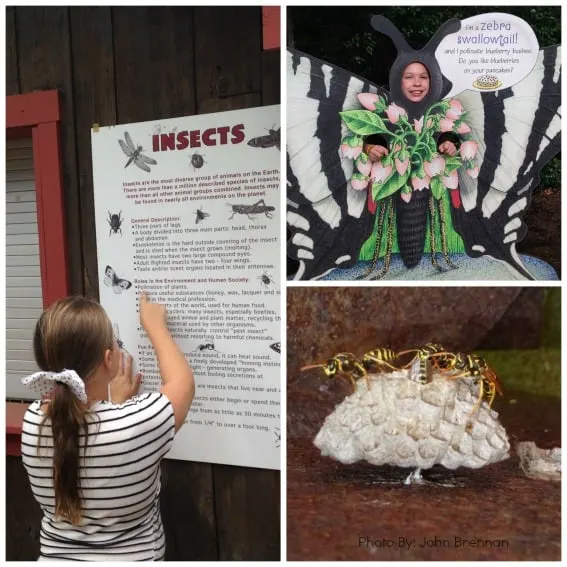 Older kids are beginning to have a sense of their place in our vast world. Learning more about insect life cycles and their impact on the environment can only serve to increase this sensitivity. I can attest that by learning to respect these smallest of living creatures my children have learned a healthy respect for all living things. On the most basic level, we have learned that not all insect life can be labeled as pests and we are not random bug squishers. For instance, European honeybees are important agricultural pollinators as are over 2,000 other native North American insects such as flies, bumble bees, solitary bees, and wasps. We consider it important to let others be aware of the differences between honey bees and yellow jackets since we need insect pollination for farming and food. Adolescents are also keen on interesting factoids about insects and their relationship to the human world.
Older kids are beginning to have a sense of their place in our vast world. Learning more about insect life cycles and their impact on the environment can only serve to increase this sensitivity. I can attest that by learning to respect these smallest of living creatures my children have learned a healthy respect for all living things. On the most basic level, we have learned that not all insect life can be labeled as pests and we are not random bug squishers. For instance, European honeybees are important agricultural pollinators as are over 2,000 other native North American insects such as flies, bumble bees, solitary bees, and wasps. We consider it important to let others be aware of the differences between honey bees and yellow jackets since we need insect pollination for farming and food. Adolescents are also keen on interesting factoids about insects and their relationship to the human world.
Spider silk making is fascinating. A spider can make at least 13 different types of silk and human engineers have gleaned from the masterful webs ideas for bridge construction! The Emerald Cock Roach Wasp is well-known for its exacting brain surgery techniques. Using its stinger the wasp finds a specific region of the brain of the cockroach and performs a lobotomy making it lose its will to walk. The cockroach becomes the slave of the wasp! The tracking of the pesky Emerald Ash Borer, which kills ash trees has been assisted by the use of a wasp called the Smokey Winged Bandit. Where you find the Bandit, you can usually find the paralyzed pest. These types of facts and relationships make learning about insects fun and can lead to future exciting studies of parasites, hosts, and ecology.
At home, older child can learn from bee keepers, go on hunts with a field guide and magnifying glass, or become part of a study. Older children can delve deeper into this fascinating field by becoming an at home research scientists. The Cornell University Lost Lady Bug project is looking for participants to help them find native ladybugs that are becoming extinct at an alarming rate. Children can also help monitor dragonfly migration in an international network of citizen scientists through SciStarter. Children 14 and older are eligible for internship opportunities at the Smithsonian Natural History Museum, which is a great way to increase knowledge.There are endless ideas to expand an older child’s knowledge and understanding of entomology.
Get Out and Explore Near and Far
There are many opportunities to travel and explore the local environments for insect and other arthropod life. By focusing on learning about insects, children become very observant and aware of their place in our natural world. It is unbelievable what those young eyes can find! Travel near and far to find opportunities to increase knowledge and keep children interested. Hiking in the New England woods has taught us so much about the ecosystems of this region, and we are able to contrast that by studying more exotic ecosystems elsewhere.We have learned that our beloved Monarch loves to travel too! The Monarch Butterfly migrates every autumn to escape cooler,northern temperatures to warmer areas of North America. This helps the population survive not only the cooler temperatures but also helps sustain the larval food source.Eastern dwelling Monarchs head to Mexico and western dwellers head to California. The Monarchs will find the same trees to roost that their relatives used four generations earlier!
Costa Rica, Hawaii, and the Virgin Islands are all terrific unspoiled places to learn about insects. Monteverde National Park in Costa Rica, Hawaii Volcanoes National Park on the Big Island, and Virgin Islands National Park in St. John are great starting points for your exploration. In Costa Rica, learn about the Leaf Cutter Ants, in Hawaii the Happy Face Spider, or in St. John the awesome tarantulas. Of course, these are just starting points, but why not take the show on the road?
Find Buggy fun in your neck of the woods:
Cleveland, OH | Columbus, OH | New Jersey | Pennsylvania | Pittsburgh, PA | Seattle & Tacoma, WA | Toronto, Canada | Washington D.C.
Books & Resources
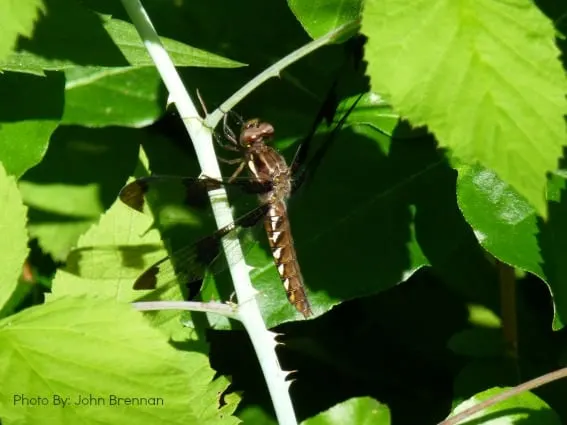
The Connecticut Agricultural Experiment Station is an independent state and grant funded facility where highly trained scientists conduct significant experiments to discover ways to help society. Part of this research is with insects that might help us, and also how we might best control pests. We had the pleasure of using this facility when we had an unknown insect pest infestation that required identification and advice. The scientists on-hand at the insect inquiry office were very helpful in identifying the mites our gerbils had become infested with, and offered a safe and nontoxic way for us to treat them. The children were 100% involved. I highly recommend that you check your state for a similar facility for your insect lover.
Check out Trekaroo reviews on great places to take bug lovers along the East Coast.
Field Guides are an important resource for insect and zoological study. Find one that is appropriate for your child’s age and knowledge level, and build as you go. These are some of our favorites: For the younger child, check out DK Big Book of Bugs. School aged children will enjoy Bugs the World’s Most Terrifying Insects; while older Children or advanced learners can learn from either the Kaufman Field Guide to Insects of North America or the National Audubon Society: Field Guide to Insects and Spiders.
Looking for more Road School Guides? Check out our landing page where we keep all our latest tips, tricks, and educationally approved guides.
Special thanks to Dr. Gale E Ridge from the Connecticut Agricultural Experiment Station in New Haven, Connecticut for her input and advice on this story.
* Disclosure: This post contains Amazon affiliate links.
- 12 Spectacular New England Fall Road Trips for Families in 2022 - August 18, 2021
- 10 Fun Things to do With Kids in New England - April 20, 2021
- Top 10 Fun Things to do in Rhode Island with Kids on a Family Vacation - March 10, 2021


